Comprehensive Report: Carbon Emission and Environmental Impact
VerifiedAdded on 2020/02/18
|16
|4178
|408
Report
AI Summary
This report delves into the multifaceted issue of carbon emissions and their environmental impact. It begins by highlighting the increasing concerns related to pollution and globalization, emphasizing the significance of reducing CO2 levels to mitigate climate change. The report explores the social costs of unrestricted carbon emissions, including air and water pollution, and examines the economic implications of industrial practices in both developed and developing countries. It further analyzes market failures associated with greenhouse gas emissions, discussing policy interventions such as emission quotas and technological advancements. The report also examines the factors influencing discounting rates, including the social rate of time preference, projected growth rates, and the rate of change in social value assigned to consumption. Finally, the report evaluates Australia's electricity production, comparing renewable and non-renewable resources, and discussing the challenges and constraints associated with each, particularly the shift from coal to renewable sources.
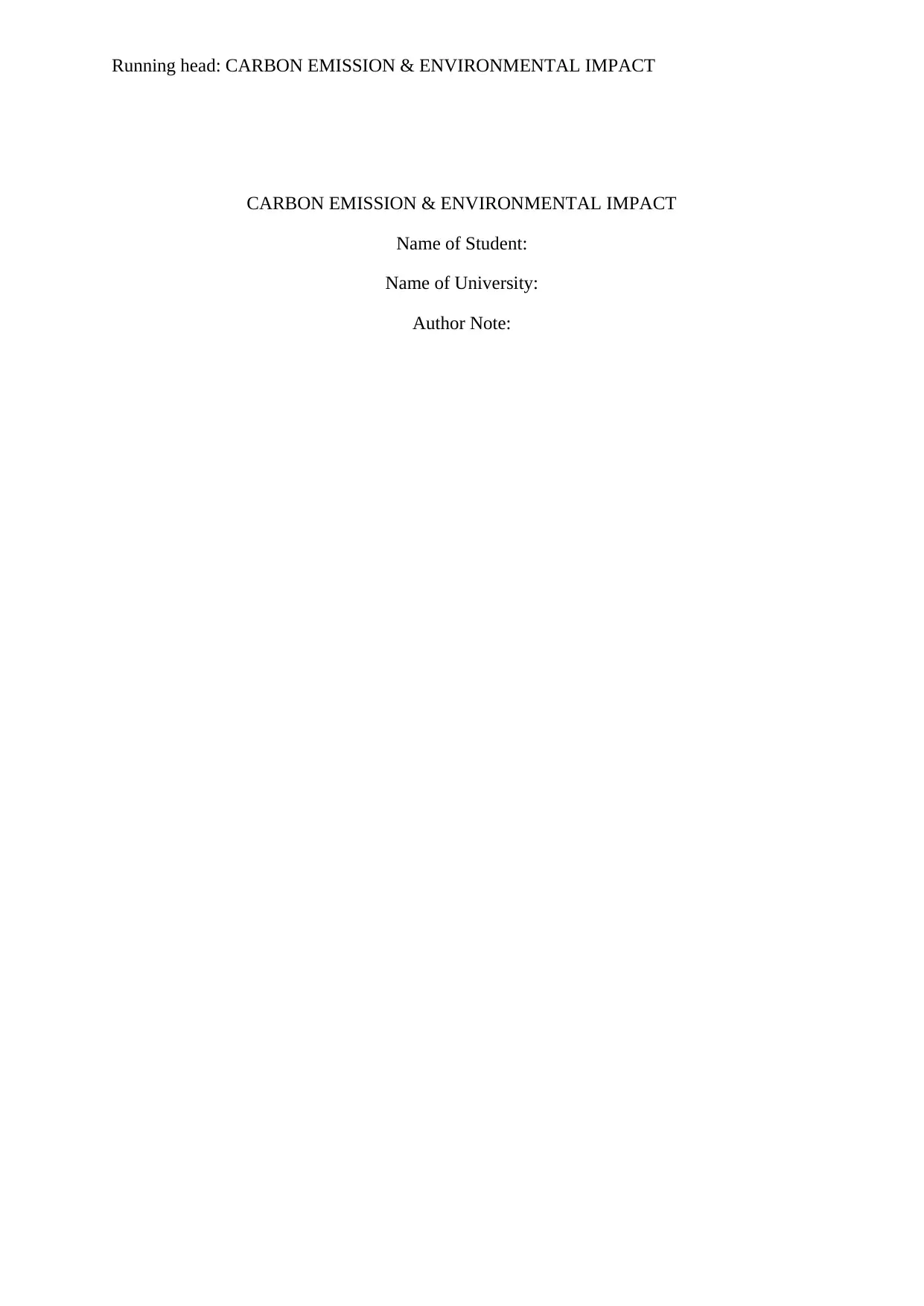
Running head: CARBON EMISSION & ENVIRONMENTAL IMPACT
CARBON EMISSION & ENVIRONMENTAL IMPACT
Name of Student:
Name of University:
Author Note:
CARBON EMISSION & ENVIRONMENTAL IMPACT
Name of Student:
Name of University:
Author Note:
Paraphrase This Document
Need a fresh take? Get an instant paraphrase of this document with our AI Paraphraser
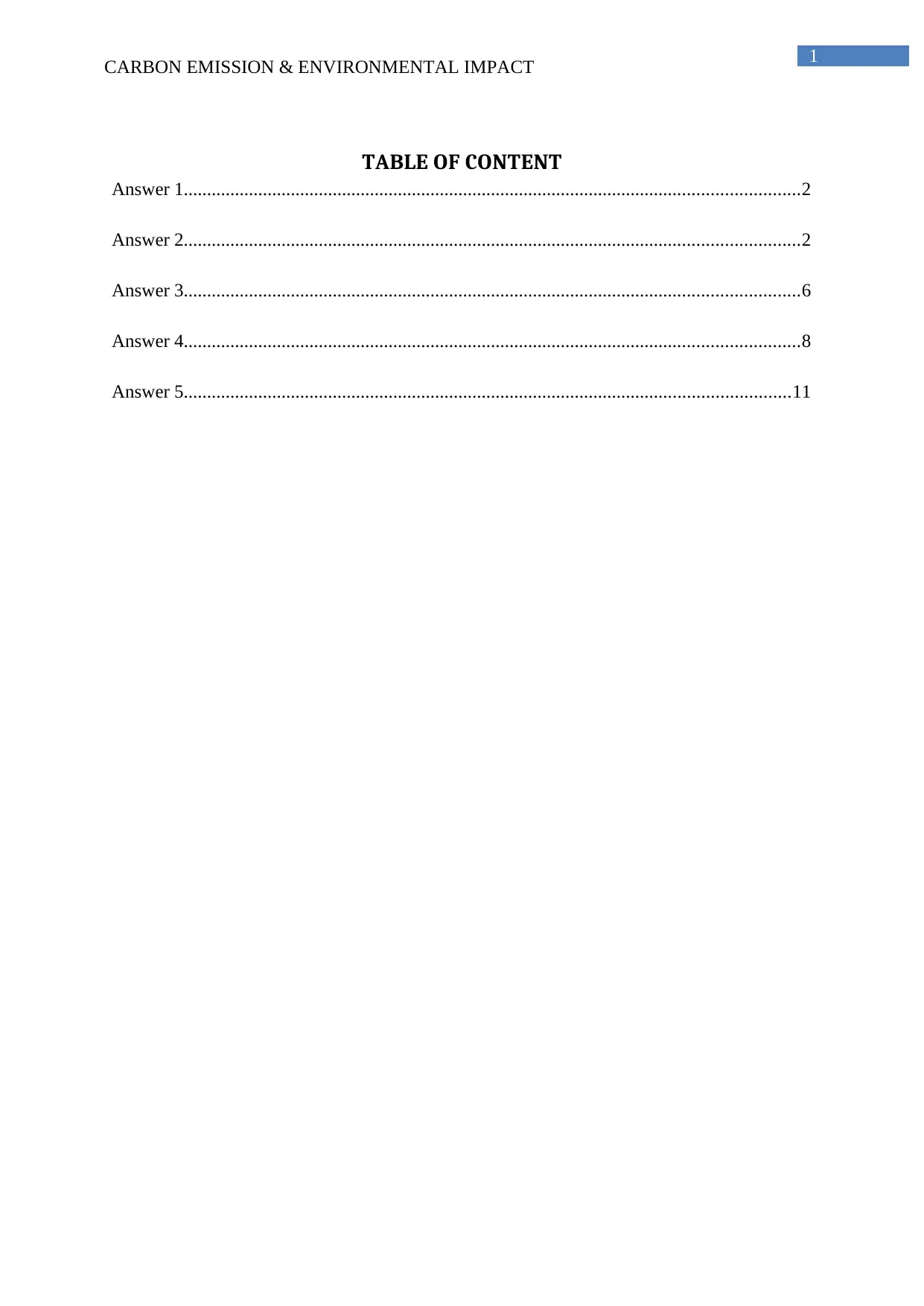
1
CARBON EMISSION & ENVIRONMENTAL IMPACT
TABLE OF CONTENT
Answer 1....................................................................................................................................2
Answer 2....................................................................................................................................2
Answer 3....................................................................................................................................6
Answer 4....................................................................................................................................8
Answer 5..................................................................................................................................11
CARBON EMISSION & ENVIRONMENTAL IMPACT
TABLE OF CONTENT
Answer 1....................................................................................................................................2
Answer 2....................................................................................................................................2
Answer 3....................................................................................................................................6
Answer 4....................................................................................................................................8
Answer 5..................................................................................................................................11
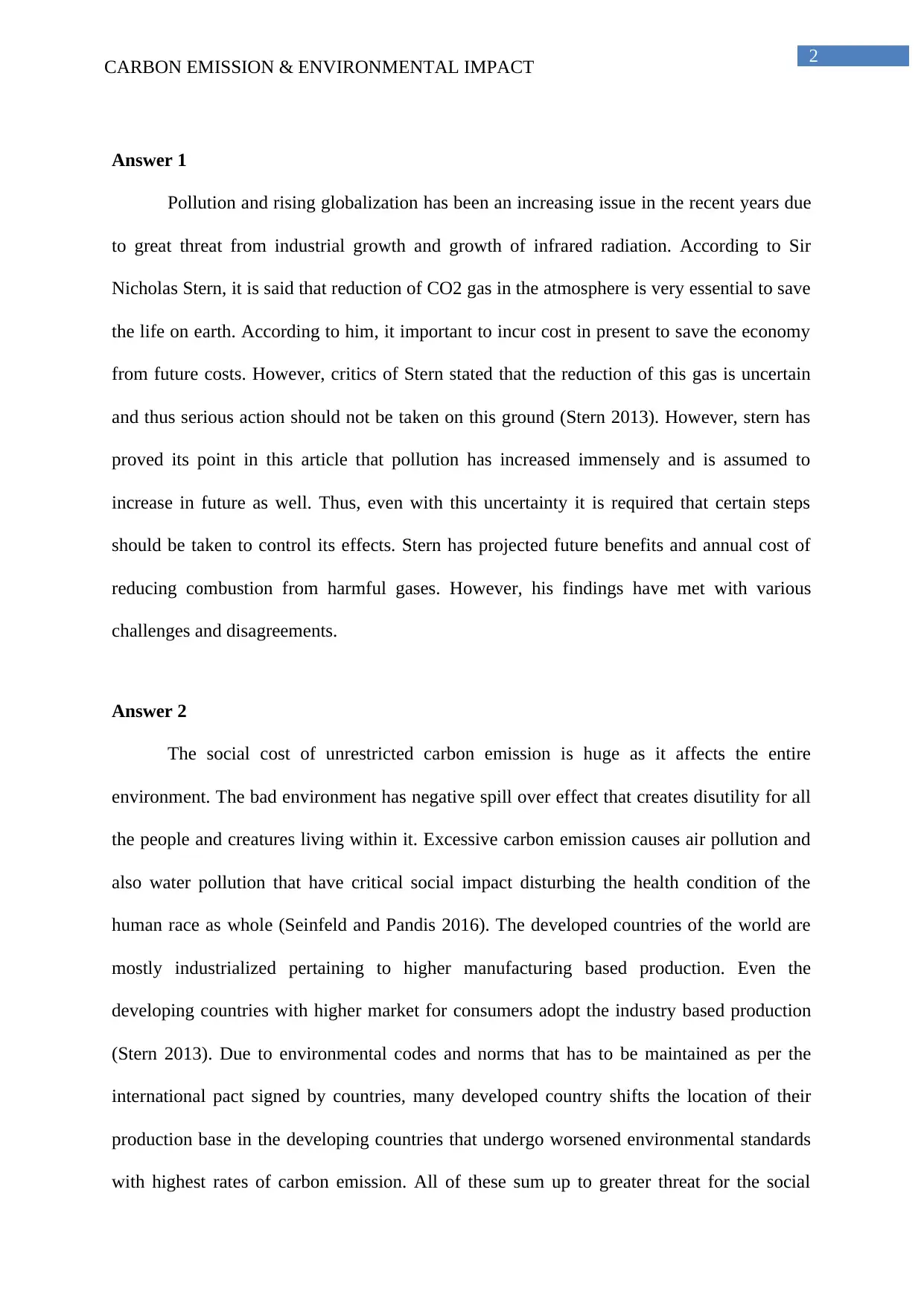
2
CARBON EMISSION & ENVIRONMENTAL IMPACT
Answer 1
Pollution and rising globalization has been an increasing issue in the recent years due
to great threat from industrial growth and growth of infrared radiation. According to Sir
Nicholas Stern, it is said that reduction of CO2 gas in the atmosphere is very essential to save
the life on earth. According to him, it important to incur cost in present to save the economy
from future costs. However, critics of Stern stated that the reduction of this gas is uncertain
and thus serious action should not be taken on this ground (Stern 2013). However, stern has
proved its point in this article that pollution has increased immensely and is assumed to
increase in future as well. Thus, even with this uncertainty it is required that certain steps
should be taken to control its effects. Stern has projected future benefits and annual cost of
reducing combustion from harmful gases. However, his findings have met with various
challenges and disagreements.
Answer 2
The social cost of unrestricted carbon emission is huge as it affects the entire
environment. The bad environment has negative spill over effect that creates disutility for all
the people and creatures living within it. Excessive carbon emission causes air pollution and
also water pollution that have critical social impact disturbing the health condition of the
human race as whole (Seinfeld and Pandis 2016). The developed countries of the world are
mostly industrialized pertaining to higher manufacturing based production. Even the
developing countries with higher market for consumers adopt the industry based production
(Stern 2013). Due to environmental codes and norms that has to be maintained as per the
international pact signed by countries, many developed country shifts the location of their
production base in the developing countries that undergo worsened environmental standards
with highest rates of carbon emission. All of these sum up to greater threat for the social
CARBON EMISSION & ENVIRONMENTAL IMPACT
Answer 1
Pollution and rising globalization has been an increasing issue in the recent years due
to great threat from industrial growth and growth of infrared radiation. According to Sir
Nicholas Stern, it is said that reduction of CO2 gas in the atmosphere is very essential to save
the life on earth. According to him, it important to incur cost in present to save the economy
from future costs. However, critics of Stern stated that the reduction of this gas is uncertain
and thus serious action should not be taken on this ground (Stern 2013). However, stern has
proved its point in this article that pollution has increased immensely and is assumed to
increase in future as well. Thus, even with this uncertainty it is required that certain steps
should be taken to control its effects. Stern has projected future benefits and annual cost of
reducing combustion from harmful gases. However, his findings have met with various
challenges and disagreements.
Answer 2
The social cost of unrestricted carbon emission is huge as it affects the entire
environment. The bad environment has negative spill over effect that creates disutility for all
the people and creatures living within it. Excessive carbon emission causes air pollution and
also water pollution that have critical social impact disturbing the health condition of the
human race as whole (Seinfeld and Pandis 2016). The developed countries of the world are
mostly industrialized pertaining to higher manufacturing based production. Even the
developing countries with higher market for consumers adopt the industry based production
(Stern 2013). Due to environmental codes and norms that has to be maintained as per the
international pact signed by countries, many developed country shifts the location of their
production base in the developing countries that undergo worsened environmental standards
with highest rates of carbon emission. All of these sum up to greater threat for the social
⊘ This is a preview!⊘
Do you want full access?
Subscribe today to unlock all pages.

Trusted by 1+ million students worldwide
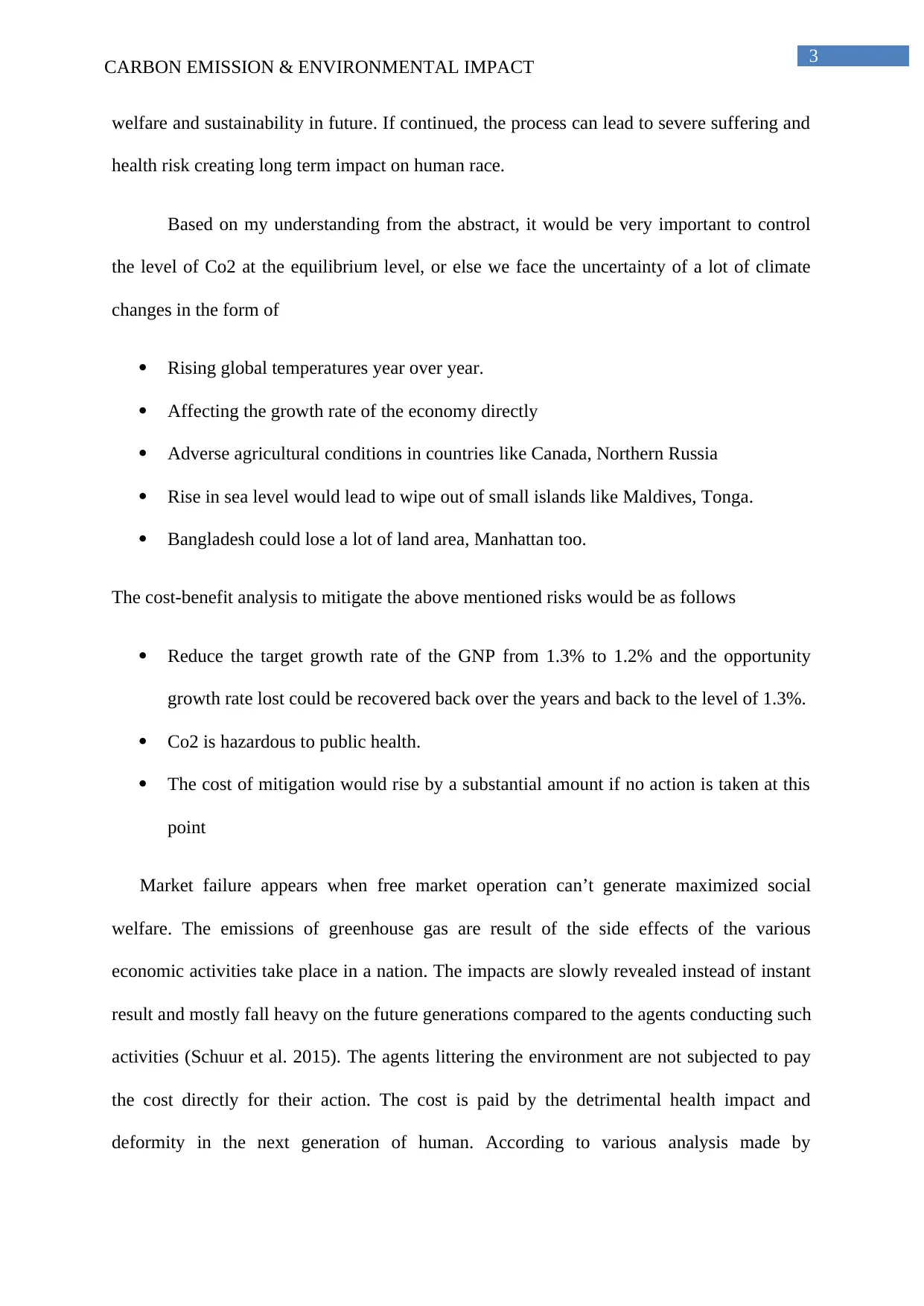
3
CARBON EMISSION & ENVIRONMENTAL IMPACT
welfare and sustainability in future. If continued, the process can lead to severe suffering and
health risk creating long term impact on human race.
Based on my understanding from the abstract, it would be very important to control
the level of Co2 at the equilibrium level, or else we face the uncertainty of a lot of climate
changes in the form of
Rising global temperatures year over year.
Affecting the growth rate of the economy directly
Adverse agricultural conditions in countries like Canada, Northern Russia
Rise in sea level would lead to wipe out of small islands like Maldives, Tonga.
Bangladesh could lose a lot of land area, Manhattan too.
The cost-benefit analysis to mitigate the above mentioned risks would be as follows
Reduce the target growth rate of the GNP from 1.3% to 1.2% and the opportunity
growth rate lost could be recovered back over the years and back to the level of 1.3%.
Co2 is hazardous to public health.
The cost of mitigation would rise by a substantial amount if no action is taken at this
point
Market failure appears when free market operation can’t generate maximized social
welfare. The emissions of greenhouse gas are result of the side effects of the various
economic activities take place in a nation. The impacts are slowly revealed instead of instant
result and mostly fall heavy on the future generations compared to the agents conducting such
activities (Schuur et al. 2015). The agents littering the environment are not subjected to pay
the cost directly for their action. The cost is paid by the detrimental health impact and
deformity in the next generation of human. According to various analysis made by
CARBON EMISSION & ENVIRONMENTAL IMPACT
welfare and sustainability in future. If continued, the process can lead to severe suffering and
health risk creating long term impact on human race.
Based on my understanding from the abstract, it would be very important to control
the level of Co2 at the equilibrium level, or else we face the uncertainty of a lot of climate
changes in the form of
Rising global temperatures year over year.
Affecting the growth rate of the economy directly
Adverse agricultural conditions in countries like Canada, Northern Russia
Rise in sea level would lead to wipe out of small islands like Maldives, Tonga.
Bangladesh could lose a lot of land area, Manhattan too.
The cost-benefit analysis to mitigate the above mentioned risks would be as follows
Reduce the target growth rate of the GNP from 1.3% to 1.2% and the opportunity
growth rate lost could be recovered back over the years and back to the level of 1.3%.
Co2 is hazardous to public health.
The cost of mitigation would rise by a substantial amount if no action is taken at this
point
Market failure appears when free market operation can’t generate maximized social
welfare. The emissions of greenhouse gas are result of the side effects of the various
economic activities take place in a nation. The impacts are slowly revealed instead of instant
result and mostly fall heavy on the future generations compared to the agents conducting such
activities (Schuur et al. 2015). The agents littering the environment are not subjected to pay
the cost directly for their action. The cost is paid by the detrimental health impact and
deformity in the next generation of human. According to various analysis made by
Paraphrase This Document
Need a fresh take? Get an instant paraphrase of this document with our AI Paraphraser
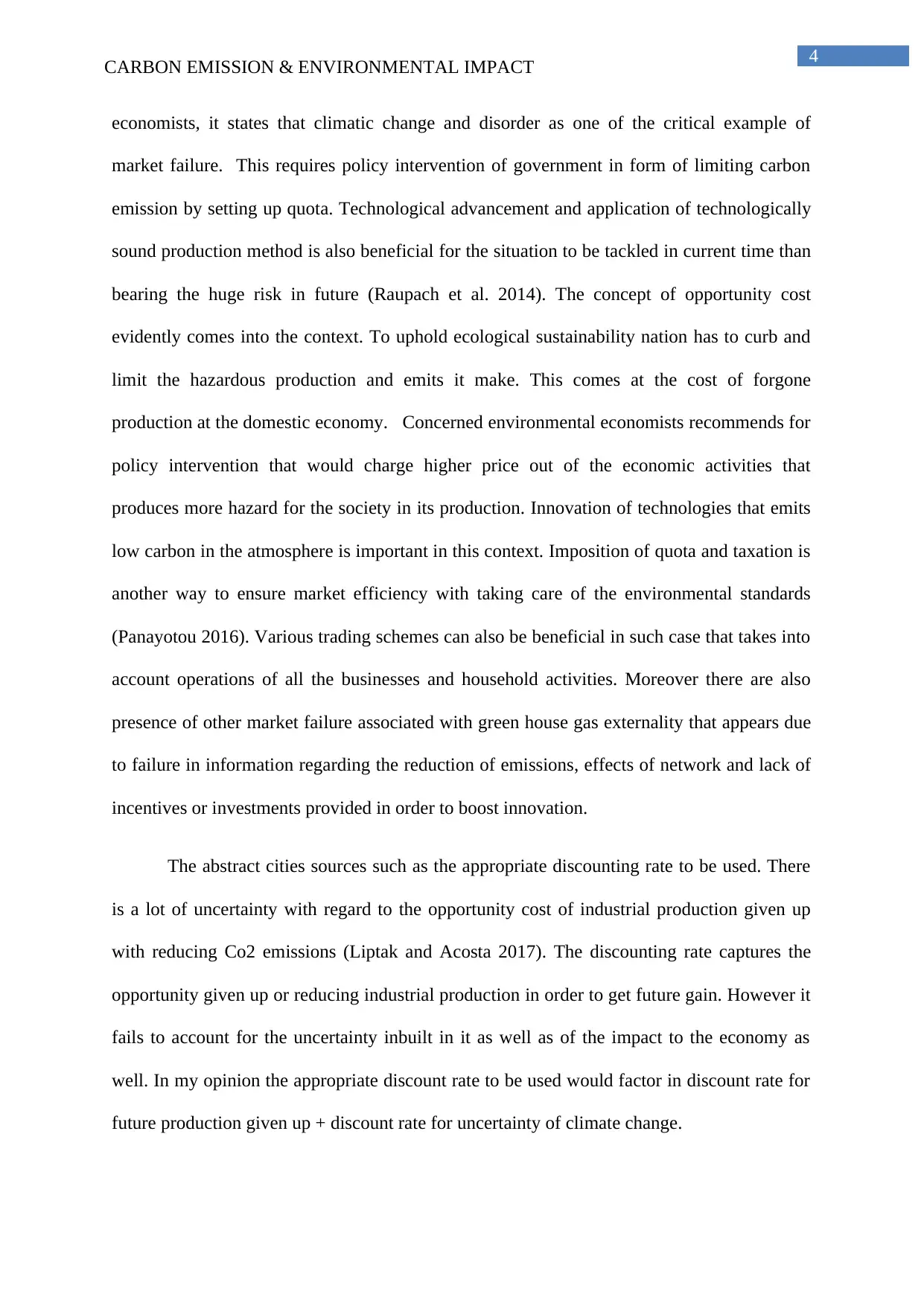
4
CARBON EMISSION & ENVIRONMENTAL IMPACT
economists, it states that climatic change and disorder as one of the critical example of
market failure. This requires policy intervention of government in form of limiting carbon
emission by setting up quota. Technological advancement and application of technologically
sound production method is also beneficial for the situation to be tackled in current time than
bearing the huge risk in future (Raupach et al. 2014). The concept of opportunity cost
evidently comes into the context. To uphold ecological sustainability nation has to curb and
limit the hazardous production and emits it make. This comes at the cost of forgone
production at the domestic economy. Concerned environmental economists recommends for
policy intervention that would charge higher price out of the economic activities that
produces more hazard for the society in its production. Innovation of technologies that emits
low carbon in the atmosphere is important in this context. Imposition of quota and taxation is
another way to ensure market efficiency with taking care of the environmental standards
(Panayotou 2016). Various trading schemes can also be beneficial in such case that takes into
account operations of all the businesses and household activities. Moreover there are also
presence of other market failure associated with green house gas externality that appears due
to failure in information regarding the reduction of emissions, effects of network and lack of
incentives or investments provided in order to boost innovation.
The abstract cities sources such as the appropriate discounting rate to be used. There
is a lot of uncertainty with regard to the opportunity cost of industrial production given up
with reducing Co2 emissions (Liptak and Acosta 2017). The discounting rate captures the
opportunity given up or reducing industrial production in order to get future gain. However it
fails to account for the uncertainty inbuilt in it as well as of the impact to the economy as
well. In my opinion the appropriate discount rate to be used would factor in discount rate for
future production given up + discount rate for uncertainty of climate change.
CARBON EMISSION & ENVIRONMENTAL IMPACT
economists, it states that climatic change and disorder as one of the critical example of
market failure. This requires policy intervention of government in form of limiting carbon
emission by setting up quota. Technological advancement and application of technologically
sound production method is also beneficial for the situation to be tackled in current time than
bearing the huge risk in future (Raupach et al. 2014). The concept of opportunity cost
evidently comes into the context. To uphold ecological sustainability nation has to curb and
limit the hazardous production and emits it make. This comes at the cost of forgone
production at the domestic economy. Concerned environmental economists recommends for
policy intervention that would charge higher price out of the economic activities that
produces more hazard for the society in its production. Innovation of technologies that emits
low carbon in the atmosphere is important in this context. Imposition of quota and taxation is
another way to ensure market efficiency with taking care of the environmental standards
(Panayotou 2016). Various trading schemes can also be beneficial in such case that takes into
account operations of all the businesses and household activities. Moreover there are also
presence of other market failure associated with green house gas externality that appears due
to failure in information regarding the reduction of emissions, effects of network and lack of
incentives or investments provided in order to boost innovation.
The abstract cities sources such as the appropriate discounting rate to be used. There
is a lot of uncertainty with regard to the opportunity cost of industrial production given up
with reducing Co2 emissions (Liptak and Acosta 2017). The discounting rate captures the
opportunity given up or reducing industrial production in order to get future gain. However it
fails to account for the uncertainty inbuilt in it as well as of the impact to the economy as
well. In my opinion the appropriate discount rate to be used would factor in discount rate for
future production given up + discount rate for uncertainty of climate change.
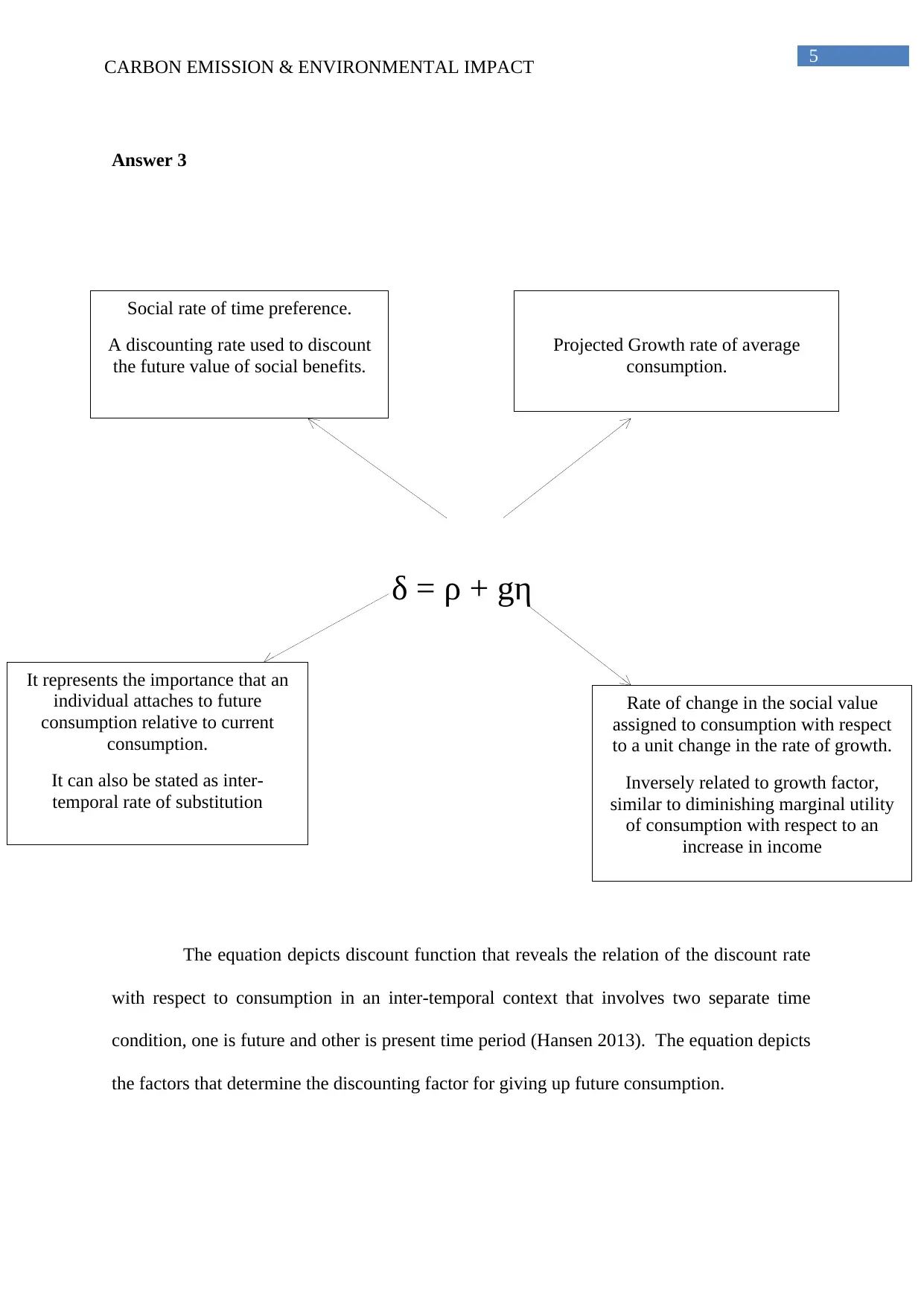
5
CARBON EMISSION & ENVIRONMENTAL IMPACT
Answer 3
δ = ρ + gη
The equation depicts discount function that reveals the relation of the discount rate
with respect to consumption in an inter-temporal context that involves two separate time
condition, one is future and other is present time period (Hansen 2013). The equation depicts
the factors that determine the discounting factor for giving up future consumption.
It represents the importance that an
individual attaches to future
consumption relative to current
consumption.
It can also be stated as inter-
temporal rate of substitution
Social rate of time preference.
A discounting rate used to discount
the future value of social benefits.
Projected Growth rate of average
consumption.
Rate of change in the social value
assigned to consumption with respect
to a unit change in the rate of growth.
Inversely related to growth factor,
similar to diminishing marginal utility
of consumption with respect to an
increase in income
CARBON EMISSION & ENVIRONMENTAL IMPACT
Answer 3
δ = ρ + gη
The equation depicts discount function that reveals the relation of the discount rate
with respect to consumption in an inter-temporal context that involves two separate time
condition, one is future and other is present time period (Hansen 2013). The equation depicts
the factors that determine the discounting factor for giving up future consumption.
It represents the importance that an
individual attaches to future
consumption relative to current
consumption.
It can also be stated as inter-
temporal rate of substitution
Social rate of time preference.
A discounting rate used to discount
the future value of social benefits.
Projected Growth rate of average
consumption.
Rate of change in the social value
assigned to consumption with respect
to a unit change in the rate of growth.
Inversely related to growth factor,
similar to diminishing marginal utility
of consumption with respect to an
increase in income
⊘ This is a preview!⊘
Do you want full access?
Subscribe today to unlock all pages.

Trusted by 1+ million students worldwide
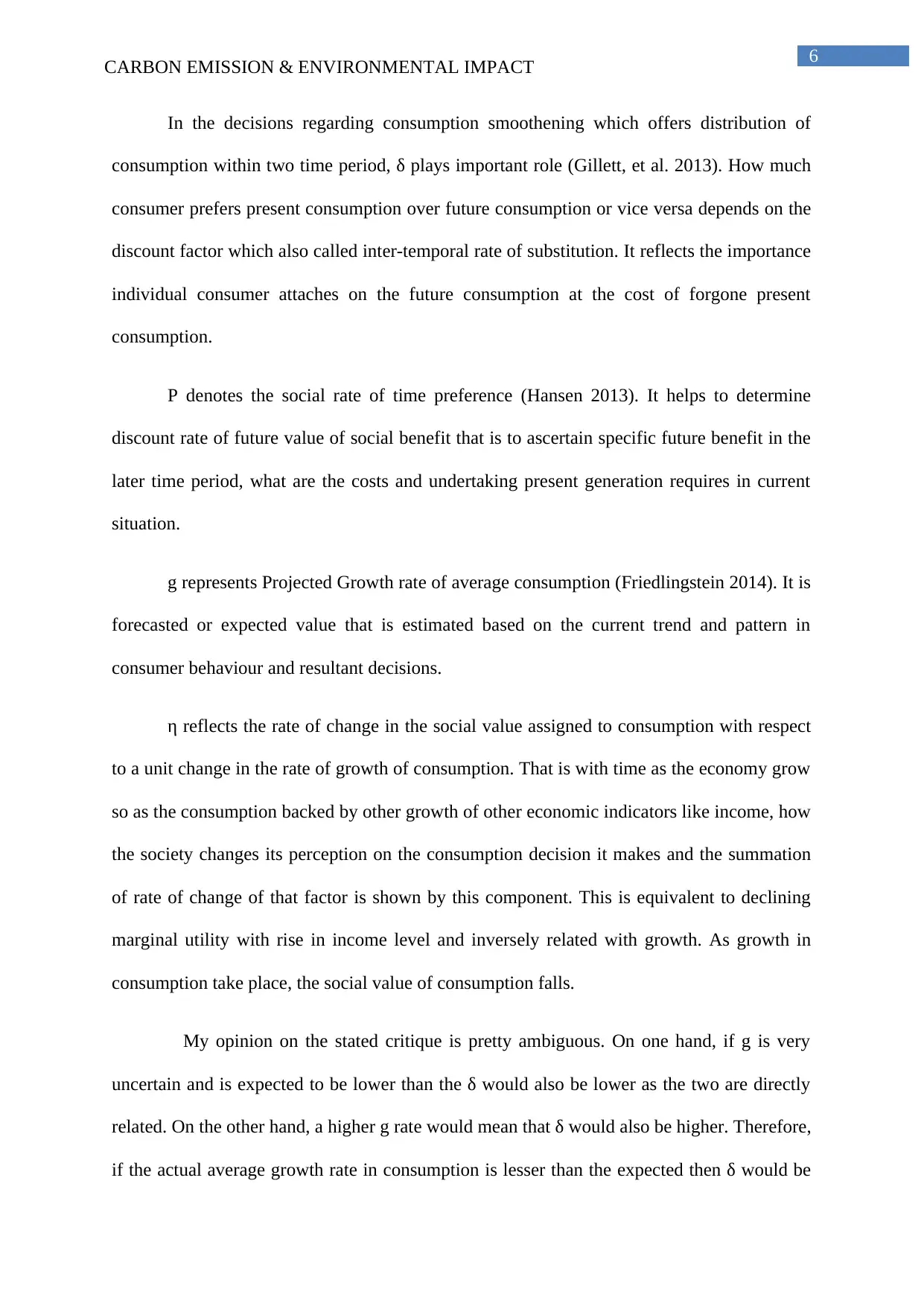
6
CARBON EMISSION & ENVIRONMENTAL IMPACT
In the decisions regarding consumption smoothening which offers distribution of
consumption within two time period, δ plays important role (Gillett, et al. 2013). How much
consumer prefers present consumption over future consumption or vice versa depends on the
discount factor which also called inter-temporal rate of substitution. It reflects the importance
individual consumer attaches on the future consumption at the cost of forgone present
consumption.
Ρ denotes the social rate of time preference (Hansen 2013). It helps to determine
discount rate of future value of social benefit that is to ascertain specific future benefit in the
later time period, what are the costs and undertaking present generation requires in current
situation.
g represents Projected Growth rate of average consumption (Friedlingstein 2014). It is
forecasted or expected value that is estimated based on the current trend and pattern in
consumer behaviour and resultant decisions.
η reflects the rate of change in the social value assigned to consumption with respect
to a unit change in the rate of growth of consumption. That is with time as the economy grow
so as the consumption backed by other growth of other economic indicators like income, how
the society changes its perception on the consumption decision it makes and the summation
of rate of change of that factor is shown by this component. This is equivalent to declining
marginal utility with rise in income level and inversely related with growth. As growth in
consumption take place, the social value of consumption falls.
My opinion on the stated critique is pretty ambiguous. On one hand, if g is very
uncertain and is expected to be lower than the δ would also be lower as the two are directly
related. On the other hand, a higher g rate would mean that δ would also be higher. Therefore,
if the actual average growth rate in consumption is lesser than the expected then δ would be
CARBON EMISSION & ENVIRONMENTAL IMPACT
In the decisions regarding consumption smoothening which offers distribution of
consumption within two time period, δ plays important role (Gillett, et al. 2013). How much
consumer prefers present consumption over future consumption or vice versa depends on the
discount factor which also called inter-temporal rate of substitution. It reflects the importance
individual consumer attaches on the future consumption at the cost of forgone present
consumption.
Ρ denotes the social rate of time preference (Hansen 2013). It helps to determine
discount rate of future value of social benefit that is to ascertain specific future benefit in the
later time period, what are the costs and undertaking present generation requires in current
situation.
g represents Projected Growth rate of average consumption (Friedlingstein 2014). It is
forecasted or expected value that is estimated based on the current trend and pattern in
consumer behaviour and resultant decisions.
η reflects the rate of change in the social value assigned to consumption with respect
to a unit change in the rate of growth of consumption. That is with time as the economy grow
so as the consumption backed by other growth of other economic indicators like income, how
the society changes its perception on the consumption decision it makes and the summation
of rate of change of that factor is shown by this component. This is equivalent to declining
marginal utility with rise in income level and inversely related with growth. As growth in
consumption take place, the social value of consumption falls.
My opinion on the stated critique is pretty ambiguous. On one hand, if g is very
uncertain and is expected to be lower than the δ would also be lower as the two are directly
related. On the other hand, a higher g rate would mean that δ would also be higher. Therefore,
if the actual average growth rate in consumption is lesser than the expected then δ would be
Paraphrase This Document
Need a fresh take? Get an instant paraphrase of this document with our AI Paraphraser
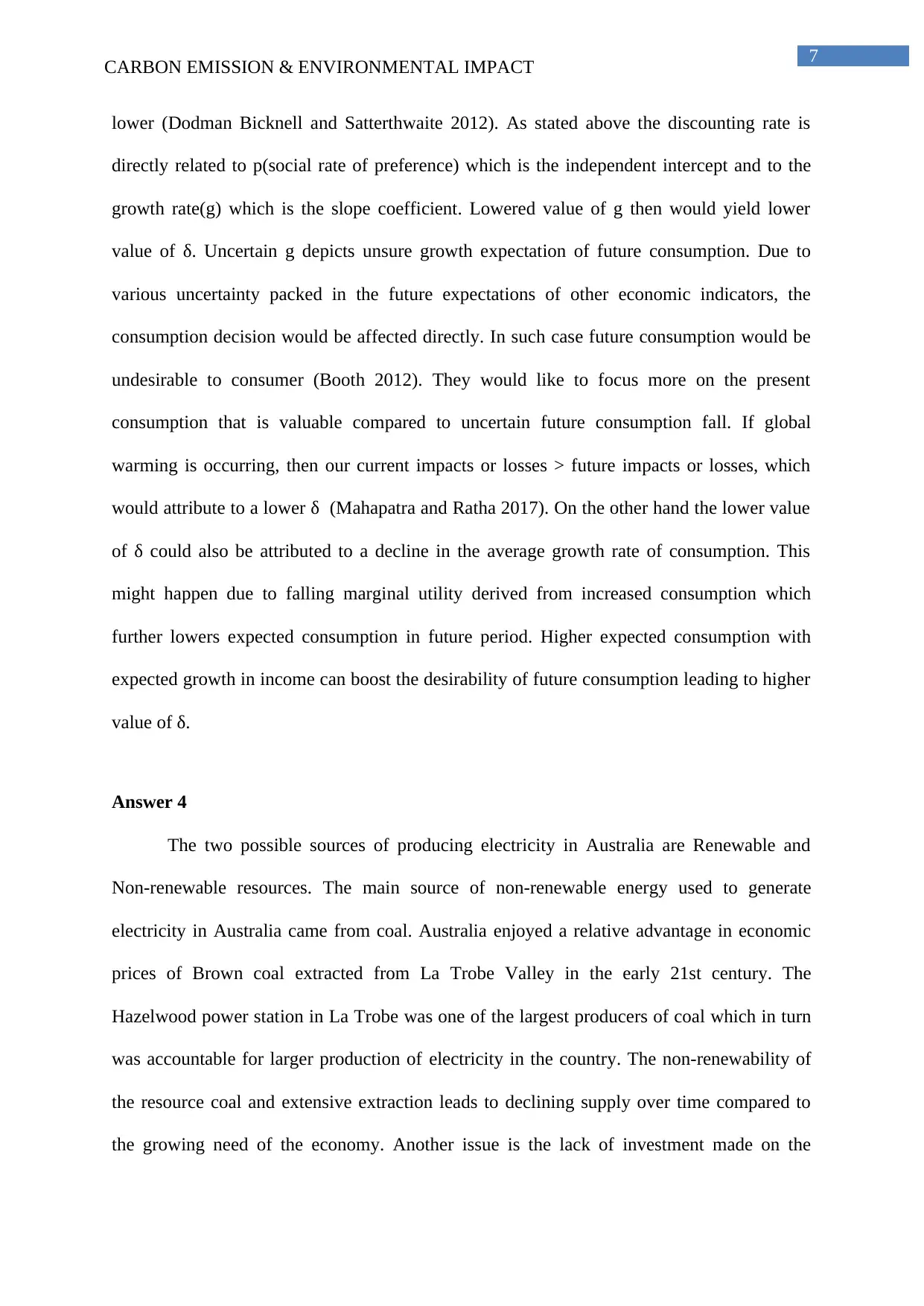
7
CARBON EMISSION & ENVIRONMENTAL IMPACT
lower (Dodman Bicknell and Satterthwaite 2012). As stated above the discounting rate is
directly related to p(social rate of preference) which is the independent intercept and to the
growth rate(g) which is the slope coefficient. Lowered value of g then would yield lower
value of δ. Uncertain g depicts unsure growth expectation of future consumption. Due to
various uncertainty packed in the future expectations of other economic indicators, the
consumption decision would be affected directly. In such case future consumption would be
undesirable to consumer (Booth 2012). They would like to focus more on the present
consumption that is valuable compared to uncertain future consumption fall. If global
warming is occurring, then our current impacts or losses > future impacts or losses, which
would attribute to a lower δ (Mahapatra and Ratha 2017). On the other hand the lower value
of δ could also be attributed to a decline in the average growth rate of consumption. This
might happen due to falling marginal utility derived from increased consumption which
further lowers expected consumption in future period. Higher expected consumption with
expected growth in income can boost the desirability of future consumption leading to higher
value of δ.
Answer 4
The two possible sources of producing electricity in Australia are Renewable and
Non-renewable resources. The main source of non-renewable energy used to generate
electricity in Australia came from coal. Australia enjoyed a relative advantage in economic
prices of Brown coal extracted from La Trobe Valley in the early 21st century. The
Hazelwood power station in La Trobe was one of the largest producers of coal which in turn
was accountable for larger production of electricity in the country. The non-renewability of
the resource coal and extensive extraction leads to declining supply over time compared to
the growing need of the economy. Another issue is the lack of investment made on the
CARBON EMISSION & ENVIRONMENTAL IMPACT
lower (Dodman Bicknell and Satterthwaite 2012). As stated above the discounting rate is
directly related to p(social rate of preference) which is the independent intercept and to the
growth rate(g) which is the slope coefficient. Lowered value of g then would yield lower
value of δ. Uncertain g depicts unsure growth expectation of future consumption. Due to
various uncertainty packed in the future expectations of other economic indicators, the
consumption decision would be affected directly. In such case future consumption would be
undesirable to consumer (Booth 2012). They would like to focus more on the present
consumption that is valuable compared to uncertain future consumption fall. If global
warming is occurring, then our current impacts or losses > future impacts or losses, which
would attribute to a lower δ (Mahapatra and Ratha 2017). On the other hand the lower value
of δ could also be attributed to a decline in the average growth rate of consumption. This
might happen due to falling marginal utility derived from increased consumption which
further lowers expected consumption in future period. Higher expected consumption with
expected growth in income can boost the desirability of future consumption leading to higher
value of δ.
Answer 4
The two possible sources of producing electricity in Australia are Renewable and
Non-renewable resources. The main source of non-renewable energy used to generate
electricity in Australia came from coal. Australia enjoyed a relative advantage in economic
prices of Brown coal extracted from La Trobe Valley in the early 21st century. The
Hazelwood power station in La Trobe was one of the largest producers of coal which in turn
was accountable for larger production of electricity in the country. The non-renewability of
the resource coal and extensive extraction leads to declining supply over time compared to
the growing need of the economy. Another issue is the lack of investment made on the
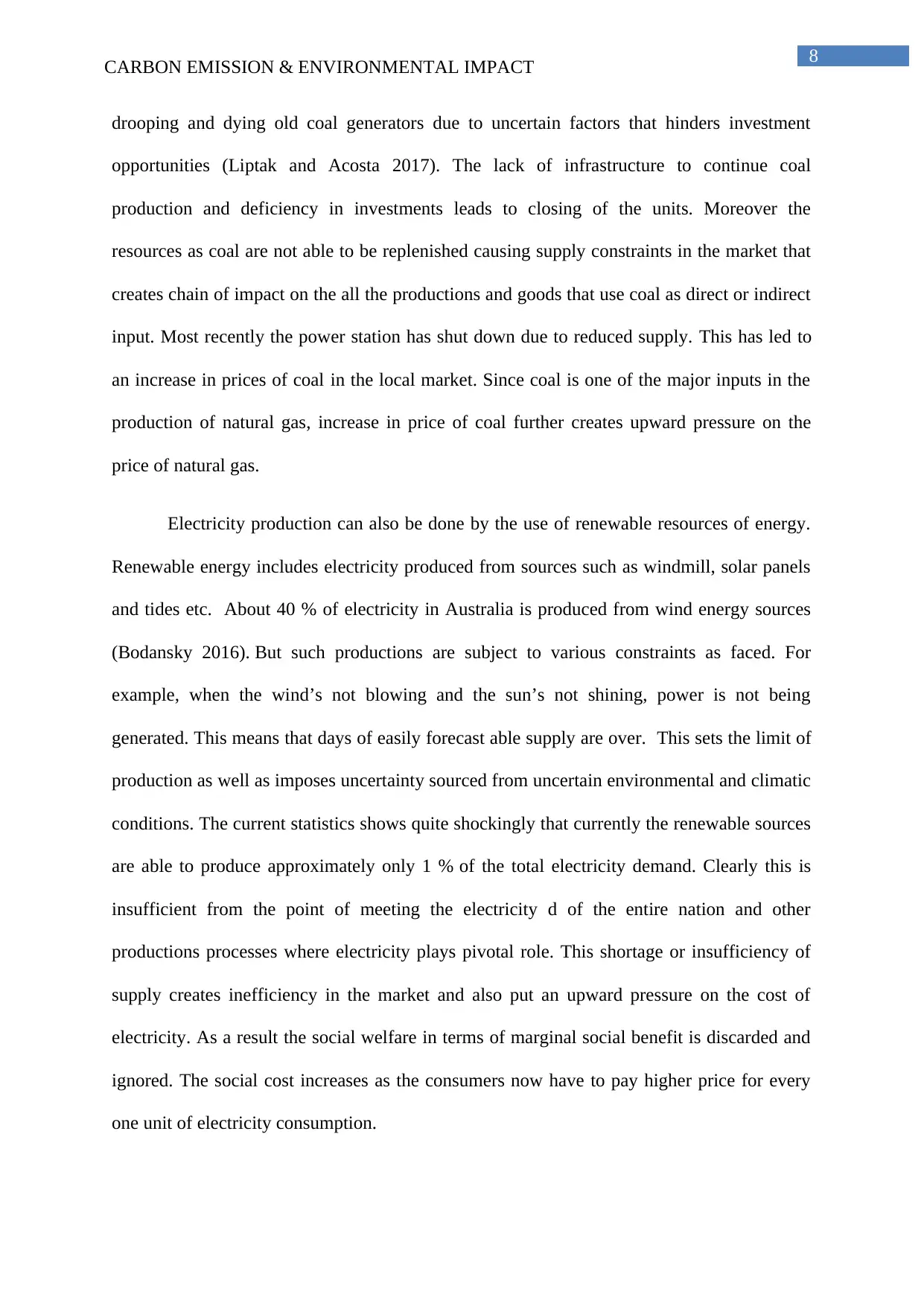
8
CARBON EMISSION & ENVIRONMENTAL IMPACT
drooping and dying old coal generators due to uncertain factors that hinders investment
opportunities (Liptak and Acosta 2017). The lack of infrastructure to continue coal
production and deficiency in investments leads to closing of the units. Moreover the
resources as coal are not able to be replenished causing supply constraints in the market that
creates chain of impact on the all the productions and goods that use coal as direct or indirect
input. Most recently the power station has shut down due to reduced supply. This has led to
an increase in prices of coal in the local market. Since coal is one of the major inputs in the
production of natural gas, increase in price of coal further creates upward pressure on the
price of natural gas.
Electricity production can also be done by the use of renewable resources of energy.
Renewable energy includes electricity produced from sources such as windmill, solar panels
and tides etc. About 40 % of electricity in Australia is produced from wind energy sources
(Bodansky 2016). But such productions are subject to various constraints as faced. For
example, when the wind’s not blowing and the sun’s not shining, power is not being
generated. This means that days of easily forecast able supply are over. This sets the limit of
production as well as imposes uncertainty sourced from uncertain environmental and climatic
conditions. The current statistics shows quite shockingly that currently the renewable sources
are able to produce approximately only 1 % of the total electricity demand. Clearly this is
insufficient from the point of meeting the electricity d of the entire nation and other
productions processes where electricity plays pivotal role. This shortage or insufficiency of
supply creates inefficiency in the market and also put an upward pressure on the cost of
electricity. As a result the social welfare in terms of marginal social benefit is discarded and
ignored. The social cost increases as the consumers now have to pay higher price for every
one unit of electricity consumption.
CARBON EMISSION & ENVIRONMENTAL IMPACT
drooping and dying old coal generators due to uncertain factors that hinders investment
opportunities (Liptak and Acosta 2017). The lack of infrastructure to continue coal
production and deficiency in investments leads to closing of the units. Moreover the
resources as coal are not able to be replenished causing supply constraints in the market that
creates chain of impact on the all the productions and goods that use coal as direct or indirect
input. Most recently the power station has shut down due to reduced supply. This has led to
an increase in prices of coal in the local market. Since coal is one of the major inputs in the
production of natural gas, increase in price of coal further creates upward pressure on the
price of natural gas.
Electricity production can also be done by the use of renewable resources of energy.
Renewable energy includes electricity produced from sources such as windmill, solar panels
and tides etc. About 40 % of electricity in Australia is produced from wind energy sources
(Bodansky 2016). But such productions are subject to various constraints as faced. For
example, when the wind’s not blowing and the sun’s not shining, power is not being
generated. This means that days of easily forecast able supply are over. This sets the limit of
production as well as imposes uncertainty sourced from uncertain environmental and climatic
conditions. The current statistics shows quite shockingly that currently the renewable sources
are able to produce approximately only 1 % of the total electricity demand. Clearly this is
insufficient from the point of meeting the electricity d of the entire nation and other
productions processes where electricity plays pivotal role. This shortage or insufficiency of
supply creates inefficiency in the market and also put an upward pressure on the cost of
electricity. As a result the social welfare in terms of marginal social benefit is discarded and
ignored. The social cost increases as the consumers now have to pay higher price for every
one unit of electricity consumption.
⊘ This is a preview!⊘
Do you want full access?
Subscribe today to unlock all pages.

Trusted by 1+ million students worldwide
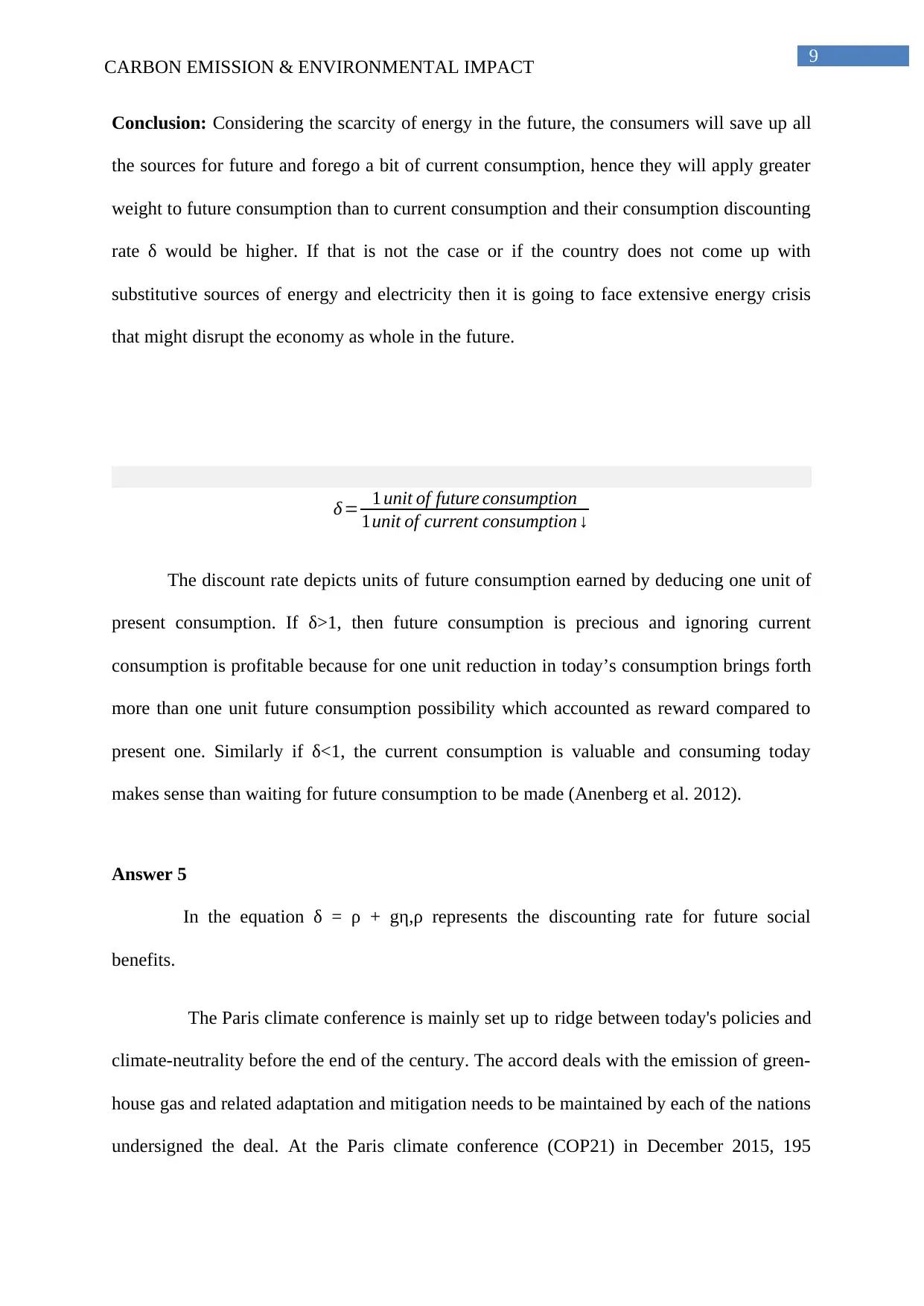
9
CARBON EMISSION & ENVIRONMENTAL IMPACT
Conclusion: Considering the scarcity of energy in the future, the consumers will save up all
the sources for future and forego a bit of current consumption, hence they will apply greater
weight to future consumption than to current consumption and their consumption discounting
rate δ would be higher. If that is not the case or if the country does not come up with
substitutive sources of energy and electricity then it is going to face extensive energy crisis
that might disrupt the economy as whole in the future.
δ = 1 unit of future consumption
1unit of current consumption ↓
The discount rate depicts units of future consumption earned by deducing one unit of
present consumption. If δ>1, then future consumption is precious and ignoring current
consumption is profitable because for one unit reduction in today’s consumption brings forth
more than one unit future consumption possibility which accounted as reward compared to
present one. Similarly if δ<1, the current consumption is valuable and consuming today
makes sense than waiting for future consumption to be made (Anenberg et al. 2012).
Answer 5
In the equation δ = ρ + gη,ρ represents the discounting rate for future social
benefits.
The Paris climate conference is mainly set up to ridge between today's policies and
climate-neutrality before the end of the century. The accord deals with the emission of green-
house gas and related adaptation and mitigation needs to be maintained by each of the nations
undersigned the deal. At the Paris climate conference (COP21) in December 2015, 195
CARBON EMISSION & ENVIRONMENTAL IMPACT
Conclusion: Considering the scarcity of energy in the future, the consumers will save up all
the sources for future and forego a bit of current consumption, hence they will apply greater
weight to future consumption than to current consumption and their consumption discounting
rate δ would be higher. If that is not the case or if the country does not come up with
substitutive sources of energy and electricity then it is going to face extensive energy crisis
that might disrupt the economy as whole in the future.
δ = 1 unit of future consumption
1unit of current consumption ↓
The discount rate depicts units of future consumption earned by deducing one unit of
present consumption. If δ>1, then future consumption is precious and ignoring current
consumption is profitable because for one unit reduction in today’s consumption brings forth
more than one unit future consumption possibility which accounted as reward compared to
present one. Similarly if δ<1, the current consumption is valuable and consuming today
makes sense than waiting for future consumption to be made (Anenberg et al. 2012).
Answer 5
In the equation δ = ρ + gη,ρ represents the discounting rate for future social
benefits.
The Paris climate conference is mainly set up to ridge between today's policies and
climate-neutrality before the end of the century. The accord deals with the emission of green-
house gas and related adaptation and mitigation needs to be maintained by each of the nations
undersigned the deal. At the Paris climate conference (COP21) in December 2015, 195
Paraphrase This Document
Need a fresh take? Get an instant paraphrase of this document with our AI Paraphraser
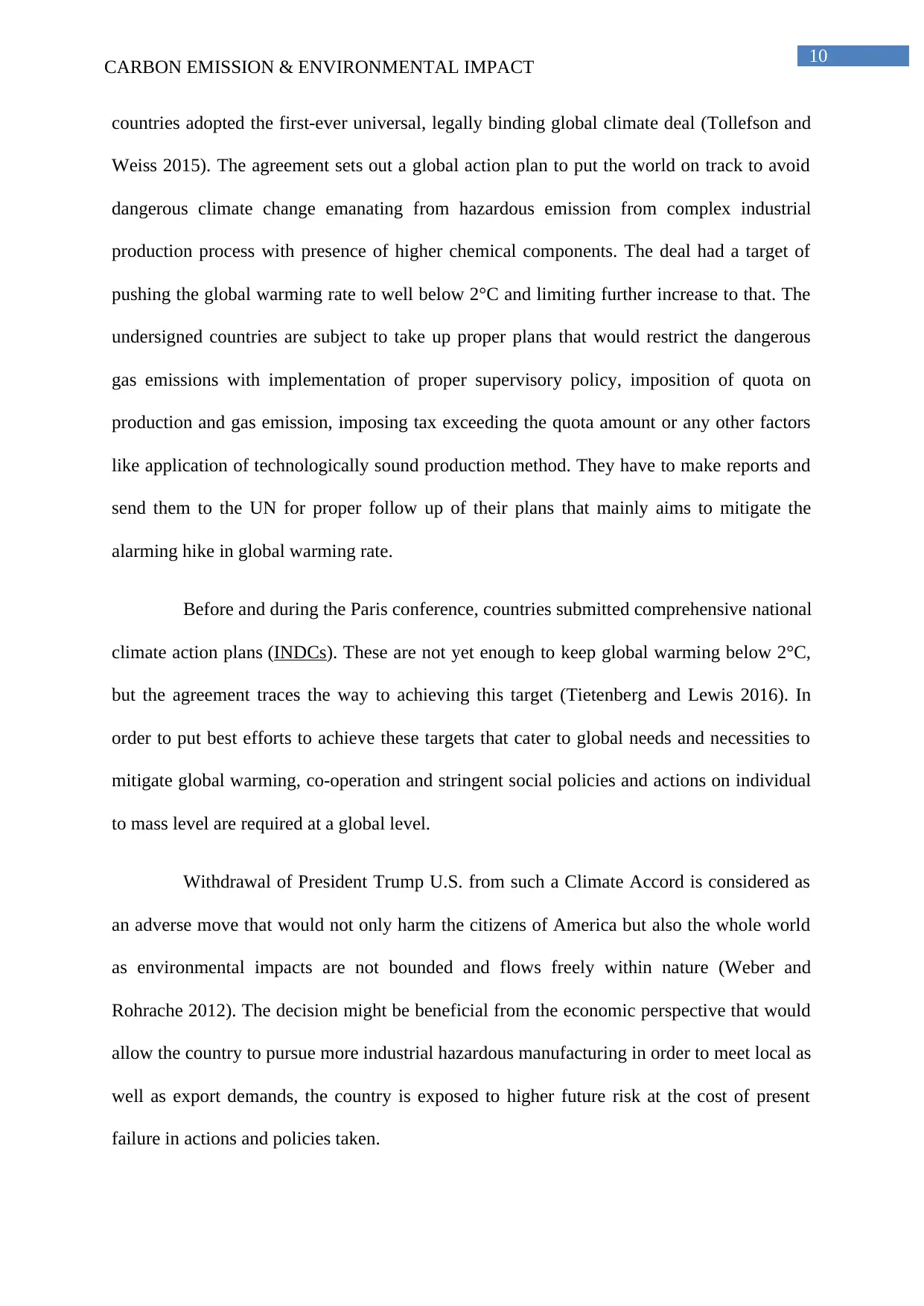
10
CARBON EMISSION & ENVIRONMENTAL IMPACT
countries adopted the first-ever universal, legally binding global climate deal (Tollefson and
Weiss 2015). The agreement sets out a global action plan to put the world on track to avoid
dangerous climate change emanating from hazardous emission from complex industrial
production process with presence of higher chemical components. The deal had a target of
pushing the global warming rate to well below 2°C and limiting further increase to that. The
undersigned countries are subject to take up proper plans that would restrict the dangerous
gas emissions with implementation of proper supervisory policy, imposition of quota on
production and gas emission, imposing tax exceeding the quota amount or any other factors
like application of technologically sound production method. They have to make reports and
send them to the UN for proper follow up of their plans that mainly aims to mitigate the
alarming hike in global warming rate.
Before and during the Paris conference, countries submitted comprehensive national
climate action plans (INDCs). These are not yet enough to keep global warming below 2°C,
but the agreement traces the way to achieving this target (Tietenberg and Lewis 2016). In
order to put best efforts to achieve these targets that cater to global needs and necessities to
mitigate global warming, co-operation and stringent social policies and actions on individual
to mass level are required at a global level.
Withdrawal of President Trump U.S. from such a Climate Accord is considered as
an adverse move that would not only harm the citizens of America but also the whole world
as environmental impacts are not bounded and flows freely within nature (Weber and
Rohrache 2012). The decision might be beneficial from the economic perspective that would
allow the country to pursue more industrial hazardous manufacturing in order to meet local as
well as export demands, the country is exposed to higher future risk at the cost of present
failure in actions and policies taken.
CARBON EMISSION & ENVIRONMENTAL IMPACT
countries adopted the first-ever universal, legally binding global climate deal (Tollefson and
Weiss 2015). The agreement sets out a global action plan to put the world on track to avoid
dangerous climate change emanating from hazardous emission from complex industrial
production process with presence of higher chemical components. The deal had a target of
pushing the global warming rate to well below 2°C and limiting further increase to that. The
undersigned countries are subject to take up proper plans that would restrict the dangerous
gas emissions with implementation of proper supervisory policy, imposition of quota on
production and gas emission, imposing tax exceeding the quota amount or any other factors
like application of technologically sound production method. They have to make reports and
send them to the UN for proper follow up of their plans that mainly aims to mitigate the
alarming hike in global warming rate.
Before and during the Paris conference, countries submitted comprehensive national
climate action plans (INDCs). These are not yet enough to keep global warming below 2°C,
but the agreement traces the way to achieving this target (Tietenberg and Lewis 2016). In
order to put best efforts to achieve these targets that cater to global needs and necessities to
mitigate global warming, co-operation and stringent social policies and actions on individual
to mass level are required at a global level.
Withdrawal of President Trump U.S. from such a Climate Accord is considered as
an adverse move that would not only harm the citizens of America but also the whole world
as environmental impacts are not bounded and flows freely within nature (Weber and
Rohrache 2012). The decision might be beneficial from the economic perspective that would
allow the country to pursue more industrial hazardous manufacturing in order to meet local as
well as export demands, the country is exposed to higher future risk at the cost of present
failure in actions and policies taken.
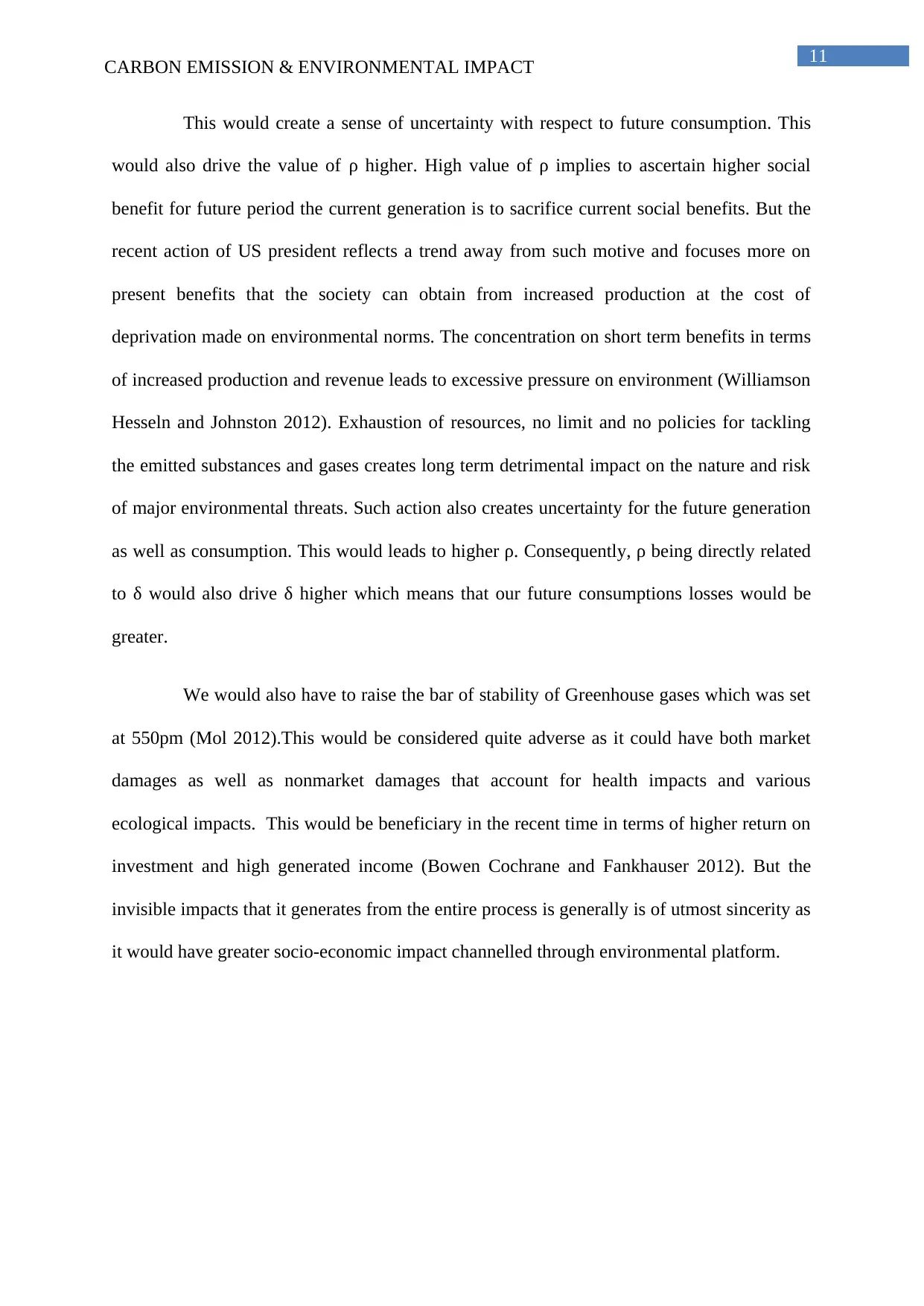
11
CARBON EMISSION & ENVIRONMENTAL IMPACT
This would create a sense of uncertainty with respect to future consumption. This
would also drive the value of ρ higher. High value of ρ implies to ascertain higher social
benefit for future period the current generation is to sacrifice current social benefits. But the
recent action of US president reflects a trend away from such motive and focuses more on
present benefits that the society can obtain from increased production at the cost of
deprivation made on environmental norms. The concentration on short term benefits in terms
of increased production and revenue leads to excessive pressure on environment (Williamson
Hesseln and Johnston 2012). Exhaustion of resources, no limit and no policies for tackling
the emitted substances and gases creates long term detrimental impact on the nature and risk
of major environmental threats. Such action also creates uncertainty for the future generation
as well as consumption. This would leads to higher ρ. Consequently, ρ being directly related
to δ would also drive δ higher which means that our future consumptions losses would be
greater.
We would also have to raise the bar of stability of Greenhouse gases which was set
at 550pm (Mol 2012).This would be considered quite adverse as it could have both market
damages as well as nonmarket damages that account for health impacts and various
ecological impacts. This would be beneficiary in the recent time in terms of higher return on
investment and high generated income (Bowen Cochrane and Fankhauser 2012). But the
invisible impacts that it generates from the entire process is generally is of utmost sincerity as
it would have greater socio-economic impact channelled through environmental platform.
CARBON EMISSION & ENVIRONMENTAL IMPACT
This would create a sense of uncertainty with respect to future consumption. This
would also drive the value of ρ higher. High value of ρ implies to ascertain higher social
benefit for future period the current generation is to sacrifice current social benefits. But the
recent action of US president reflects a trend away from such motive and focuses more on
present benefits that the society can obtain from increased production at the cost of
deprivation made on environmental norms. The concentration on short term benefits in terms
of increased production and revenue leads to excessive pressure on environment (Williamson
Hesseln and Johnston 2012). Exhaustion of resources, no limit and no policies for tackling
the emitted substances and gases creates long term detrimental impact on the nature and risk
of major environmental threats. Such action also creates uncertainty for the future generation
as well as consumption. This would leads to higher ρ. Consequently, ρ being directly related
to δ would also drive δ higher which means that our future consumptions losses would be
greater.
We would also have to raise the bar of stability of Greenhouse gases which was set
at 550pm (Mol 2012).This would be considered quite adverse as it could have both market
damages as well as nonmarket damages that account for health impacts and various
ecological impacts. This would be beneficiary in the recent time in terms of higher return on
investment and high generated income (Bowen Cochrane and Fankhauser 2012). But the
invisible impacts that it generates from the entire process is generally is of utmost sincerity as
it would have greater socio-economic impact channelled through environmental platform.
⊘ This is a preview!⊘
Do you want full access?
Subscribe today to unlock all pages.

Trusted by 1+ million students worldwide
1 out of 16
Related Documents
Your All-in-One AI-Powered Toolkit for Academic Success.
+13062052269
info@desklib.com
Available 24*7 on WhatsApp / Email
![[object Object]](/_next/static/media/star-bottom.7253800d.svg)
Unlock your academic potential
Copyright © 2020–2025 A2Z Services. All Rights Reserved. Developed and managed by ZUCOL.





